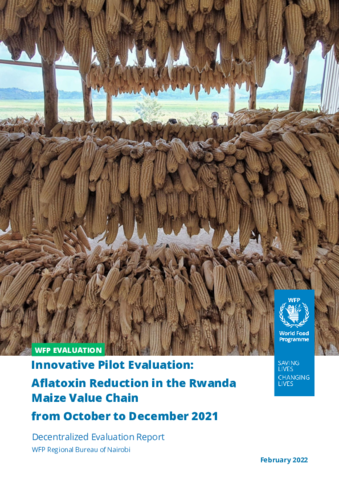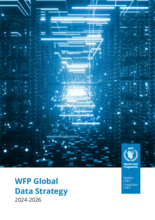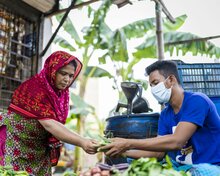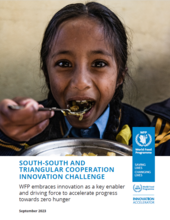
Subject of the evaluation
Maize is the third largest crop in Rwanda and is largely produced by smallholder farmers (SHFs). Access to commercial markets is limited by excessively high levels of aflatoxin levels in their crops due to fungal infections which occur as a result of poor storage in humid conditions. Aflatoxin cannot be removed from affected crops and causes acute and chronic sickness. AflaSight is a commercial start-up, supported by WFP, which aims to introduce a novel technology in Rwanda which sorts contaminated crops and removes affected grain.
Objectives and users of the evaluation
This real-time pilot evaluation was commissioned by the WFP Regional Bureau of Nairobi (RBN) to examine the performance of the technology and understand its value to SHFs and other members of the maize value chain. The report provides its main users, including WFP, AflaSight, and Government, with evidence to guide future support for AflaSight.
Methodology
The evaluation used a mixed-methods, theory-based approach. It covers the first three months of the pilot – less than initially planned due to delays in the installation of the processing line and the expiration of the WFP evaluation budget at the end of 2021. Primary data were collected in late 2021 and included interviews with key stakeholders in Kigali, as well as field visits to cooperatives in the Southern Province to conduct interviews, focus groups, and a detailed quantitative survey of 400 coop members. Data collection coincided with the roll-out of pilot activities, so findings regarding adoption, impact and sustainability are relatively speculative.
Key findings
Appropriateness for the realities and needs of the targeted beneficiaries
The pilot offers a solution for SHFs, agro-processors and traders to the widespread problem of aflatoxin. It complements existing approaches to aflatoxin reduction, such as the post-harvest practices promoted by the Farm to Market Alliance (FtMA), and is closely aligned with relevant policies and strategies of WFP and Government to ensure safe food and support SHFs.
Acceptance, understanding, and accessibility of the technology by farmers and other stakeholders
Smallholder farmers were only being made aware of the technology at the end of the evaluation period, and processing of smallholder grain began thereafter. Processors, traders and Government are positive about the potential value of the technology.
Cost-effectiveness of the pilot
For agro-processors, AflaSight is the least costly solution for aflatoxin reduction if they can offset the processing costs by buying contaminated grain at sufficiently low prices. Calculations suggest that the required price discount is only half the current price difference between premium and local markets, thus offering potential gains for both buyers and SHFs.
Performance of the technology
The technology has shown its ability to reduce aflatoxin levels – up to 80-90 percent in the most contaminated batches of grain – depending on the source of grain and initial aflatoxin content. Results for growing season A are not yet available and may be different. Weight losses from optical sorting are typically below 5 percent. The first batches of contaminated commercial grain from a cooperative have been converted to low-aflatoxin grain by the technology with no failures.
Enhancement of connections between smallholder farmers and premium buyers
The technology allows agro-processors to source a larger share of their demand for high-quality maize domestically. This additional demand will increase connections between coops and premium buyers. FtMA support plays an important role in creating the conditions for linking coops to premium buyers.
Emerging effects on the livelihoods of farmers
Any grain that would previously have been rejected (but can now reach premium markets) can bring additional income for SHFs, provided that premium buyers share their gains from the technology with farmers. Coops will need to connect with direct users of AflaSight and be sufficiently informed about the technology and the aflatoxin levels of their harvest to maximise their benefits. Any income increase, once achieved, is likely to continue in the future.
Likely outcomes within the wider market systems and maize value chain
Increased domestic high-quality grain production should reduce input costs for processors and may contribute to improved profitability, lower food prices, and increased exports of food products. Smaller unregulated mills and food producers will produce less contaminated food.
Viability of the pilot and advisability for scaling up
The business model for AflaSight seems realistic but the high fixed costs attached to the machine mean that the throughput must be high to support the costs. It is too early to assess the future demand from the maize value chain and provide specific advice on scale-up.
Adequacy of local capacity and institutional arrangements to continue its operations There are adequate aggregation and storage facilities in the country to allow for the scale-up. Government has been very supportive of the pilot so far and this is likely to continue
Conclusions and recommendations
Overall assessment
Aflatoxin is a major problem in Rwanda due to poor storage and drying facilities combined with high rainfall. Optical sorting has the potential to make a big contribution. The technology is the first to promise effective sorting of high volumes of grain to remove aflatoxin.
The machine’s performance in the pilot is likely to be sufficient to reduce aflatoxin levels in grain to within acceptance thresholds of premium buyers and increase the volume of domestic grain available to processors. The service fees for processors and traders are lower than the savings from buying initially contaminated grain at lower prices.
AflaSight should enable farmers to reduce their rejection rates, sell a larger quantity of grain to premium markets, and increase their income. Women and men will have equal access to the technology. FtMA already works closely with coops and will play an important role in the introduction of AflaSight to guide farmers and coops as to how they maximise their chances to sell to premium buyers and share the value added from the technology.
There are clear advantages for consumers and the economy. More Rwandan maize will be processed for food, and the benefits will also trickle down to small millers and producers, who will eventually receive higher quality maize as well and so produce safer food.
With only two months of commercial operations so far, the pilot needs more experience with the process itself to understand its value to potential users and to assess its potential for scale-up. The high fixed costs of the machine means that AflaSight will need to guarantee a strong market to ensure sufficient throughput.
- Recommendation 1: WFP/FtMA should support (throughout the life of the FtMA programme) coops whose grain passes through the AflaSight process, as a means of increasing the income of SHFs (and women in particular) and continuing the shift from subsistence to commercial farming.
- Recommendation 2: WFP/FtMA should continue to monitor and support the engagement of SHFs with the AflaSight pilot, fostering market links and information about the technology, to maximise farmers’ access to (and value from) it.
- Recommendation 3: The Innovation Hub for Eastern Africa, with support of the Rwanda Country Office, should mobilise innovation funding for AflaSight until the results are better understood and can inform the decision on scale-up (while already exploring funding options for scale-up).
- Recommendation 4: FP should explore opportunities to work with the Government to support its efforts to widen the enforcement of aflatoxin standards and to carry out surveys to understand better the extent of aflatoxin contamination in Rwanda.
- Recommendation 5: WFP should work with the authorities and key stakeholders to explore the opportunity to further develop a warehouse receipt system in Rwanda in the context of the quality “insurance” provided by AflaSight.
- Recommendation 6: WFP (RBN) should commission a study to identify which countries in East Africa would most benefit from access to the technology.



